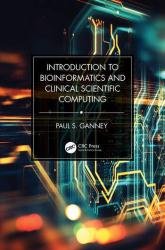 Название: Introduction to Bioinformatics and Clinical Scientific Computing
Название: Introduction to Bioinformatics and Clinical Scientific ComputingАвтор: Paul S. Ganney
Издательство: CRC Press
Год: 2023
Страниц: 405
Язык: английский
Формат: pdf (true)
Размер: 19.1 MB
This textbook provides an introduction to computer science theory, informatics best practice, and the standards and legislation that apply to computing in a healthcare environment.
It delivers an accessible discussion of databases (construction, interrogation and maintenance); networking (design and low-level application); programming (best practice rather than the specifics of any one language – design, maintenance, safety).
It can be used to accompany the NHS Modernising Scientific Careers syllabus. It is also targeted towards those creating software rather than those using it, particularly computer scientists working in healthcare, specifically those in or close to the Physical Sciences, including radiotherapy, nuclear medicine, and equipment management and those working with genomics and health informatics.
A NoSQL database provides a mechanism for storage and retrieval of data that is modelled in ways other than the tabular relations used in relational databases, “NoSQL” originally referring to “non SQL” or “non-relational” databases. Whilst such databases have existed since the late 1960s, the “NoSQL” term came to prominence in the early twenty-first century, triggered by the needs of Web 2.0 companies such as Facebook, Google and Amazon. NoSQL systems are also sometimes called “Not only SQL” to emphasise that they may support SQL-like query languages.
NoSQL is thus a loose umbrella term describing the means of storing data other than in a standard relational table schema. There are a variety of technologies under the NoSQL umbrella1:
• Document storage – e.g. Apache CouchDB, ArangoDB, BaseX, Clusterpoint, Couchbase, Cosmos DB, HyperDex, IBM Domino, MarkLogic, MongoDB,
OrientDB, Qizx, RethinkDB
• Object storage – e.g. Cache (Intersystems)
• Graph – e.g. AllegroGraph, ArangoDB, InfiniteGraph, Apache Giraph, MarkLogic, Neo4J, OrientDB, Virtuoso.
• Wide Column – e.g. Bigtable (Google), Accumulo, Cassandra, Druid, HBase, Vertica.
• Key/Value – e.g. DynamoDB (Amazon), Aerospike, Apache Ignite, ArangoDB, Couchbase, FairCom c-treeACE, FoundationDB, HyperDex, InfinityDB, MemcacheDB, MUMPS, Oracle NoSQL Database, OrientDB, Redis, Riak, Berkeley DB, SDBM/Flat File dbm, Voldemort.
Web development is not primarily an art. Neither is it purely a science. It is actually a team effort, bringing together programmers, graphic designers, content authors, interface designers, financial wizards and system testers. All web pages are basically formatted text, the format being HTML (Hyper-Text Markup Language) which essentially consists of a pair of tags4 – a start and an end – surrounding text that is controlled by those tags. The markup tells the browser how to display the text that is so denoted. The latest standard is HTML 5 and although 5.1 and 5.2 were released, work has coalesced around the Living Standard instead(WHATWG). CSS has been a feature of HTML for many years and allows the developer/designer to set an overall style for the site which is used on every page that imports the style sheet. The advantage of this is that alterations need only be made in one place to affect the entire site. Using styles clearly separates a document’s presentation layout from its structure definition. The document structure is defined using HTML. The visual appearance of the page can then be changed using a style sheet.
A common way of producing dynamic (i.e. non-static) effects on a web page is to use jаvascript. jаvascript contains the usual programming constructs, such as if…else, for… next, do…while, switch() and case(). There are also a set of string handling functions such as substr() and substring() (which do different things so be sure to get the right one).
Table of Contents:
Chapter 1 Data Structures. Chapter 2 Databases. Chapter 3 SQL. Chapter 4 Data Mining. Chapter 5 Data Analysis and Presentation. Chapter 6 Boolean Algebra. Chapter 7 NoSQL. Chapter 8 Network Architecture. Chapter 9 Storage Services. Chapter 10 Encryption. Chapter 11 Web Programming (HTML, CSS, jаvascript). Chapter 12 Data Exchange. Chapter 13 Hospital Information Systems and Interfaces. Chapter 14 Backup. Chapter 15 Software Engineering. Chapter 16 Software Quality Assurance. Chapter 17 Project Management. Chapter 18 Safety Cases. Chapter 19 Critical Path Analysis. Appendix. Index.
Скачать Introduction to Bioinformatics and Clinical Scientific Computing